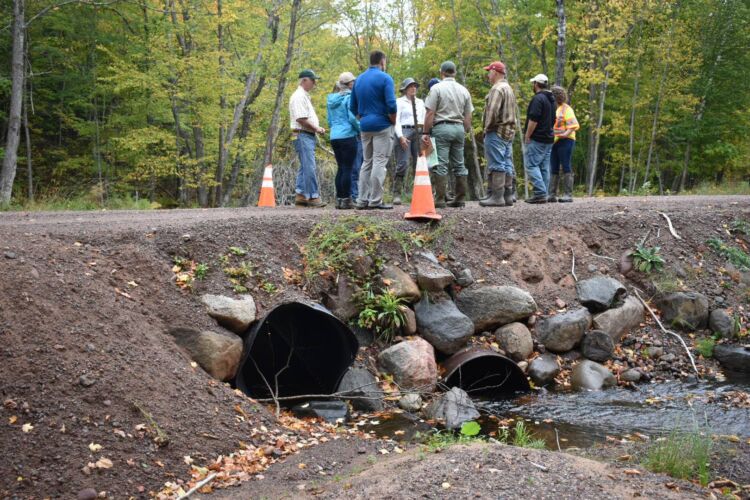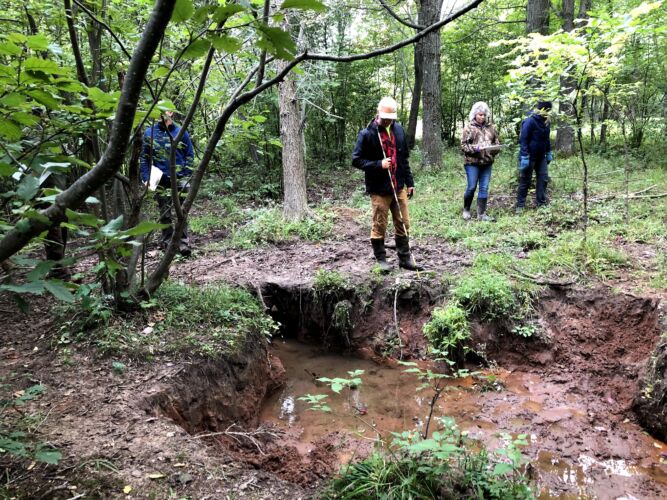Following devastating floods in 2016 and 2018, the Wisconsin Wetlands Association (WWA) helped the Ashland County Emergency Management Department apply for and secure a pre-disaster mitigation grant from the Federal Emergency Management Agency (FEMA).
The project—Rebuilding Natural Infrastructure in Ashland County—represented the state’s first FEMA-funded project focused on collecting data to identify nature-based solutions (aka natural flood management).
Project goals were to:
- Identify and characterize vulnerable infrastructure and associated fluvial erosion hazards or FEH (erosion caused by flowing floodwater).
- Synthesize assessment data to describe and scope recommended FEH mitigation practices and identify potential target areas for implementation.
- Engage stakeholders to solicit input on project activities, finalize recommendations, and append the Ashland County Hazard Mitigation Plan.
The grant supported WWA in the role of Project Manager with representatives from the U.S. Geologic Survey and the Northwest Regional Planning Commission supporting the assessment work. Project highlights included:
- Developing new methods for evaluating how loss of wetlands and degraded stream conditions contribute to flood damages.
- Identifying priority areas where wetland and floodplain restoration can help reduce future flood damage.
- Developing and securing adoption of an addendum to the Ashland County Hazard Mitigation Plan that highlights areas of high flood vulnerability and identifies strategies to apply natural flood management to address vulnerabilities. (The addendum can be accessed by visiting co.ashland.wi.us and searching “Hazard Mitigation Plan.”)
The outcomes of this work have far exceeded our expectations. Over the course of several years of work, we established an extensive and diverse network of collaborators who lent time, energy, and expertise to this and related efforts. As a result, the work has gained statewide and national attention.
All this has helped WWA and our partners secure funding for implementation of recommended restoration projects and has helped establish new collaborations for additional assessment work. Most notable is a collaboration with the Association for State Floodplain Managers for a second phase project to help quantify hydrologic and economic benefits of restoring wetlands to reduce flood flows and velocity.
In the coming year, we will also be working to help flood-prone towns within the watershed adopt new policies and practices to help them compete for federal funding for natural flood management work.
Finally, and perhaps most significant to WWA’s mission, the lessons learned along the way have informed and strengthened our policy agenda. As described earlier on our blog, our legislative and state agency priorities include building out the policy and agency program supports needed to help communities across Wisconsin evaluate and implement wetland and floodplain restoration projects to reduce flood damages. This work includes working alongside respected organizations such as Wisconsin Trout Unlimited and the Wisconsin Towns Association to help establish and secure funding for a predisaster mitigation grant program in Wisconsin.
This is some of the most consequential work the organization has ever done…and we’re just getting started.
Related content
Wetlands and flood damages: Understanding the connections
Setting our agenda for the 2023-2024 legislative cycle
Ashland County adopts Natural Flood Management strategies to protect local roads
Learn more about Ashland County Board of Supervisors approving the Hazard Mitigation Plan addendum!



